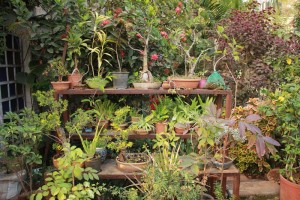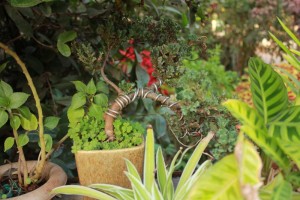Learn to Create Bonsai for your Homes and Offices
Now a days not every one can afford to have a big garden area while living in Flats and Buildings . Bonsai and Terrarium are miniature plants which you can create and mantain in tiny spaces . They also give a lively and sopisticated look to your homes and offices. Bonsai is a Janpanese art form in which Miniature trees are grown in containers .
Learning to create Bonsai is not that hard as you may think . I will be guiding you through the process step by step and explain the five stages of Creating a Bonsai .
-
Step 1 : Selection of a proper plant(stock)to begin your work with .
-
Step 2 :Select appropriate bonsai style for your selected plant .
-
Step 3:Wiring your Plant
-
Step 4:Potting your Bonsai in proper Soil
-
Step5 : Learn to Care and maintain your Bonsai
The Process of Selecting appropriate Plant for your Bonsai
Bonsai is a Process and not a special plant which is genitically engineered to stay small . Not all plants can be processed into a bonsai , so the process of selecting a proper plant according to your Cliamtic conditions and availability plays a important role .
Here is List of Trees you can use for creating Bonsai :
Fir , Maple ( Trident Maple , Hedge Maple, Amur Maple ,Montpelier Maple, Japanese Maple, Red Maple ) , Desert rose , Barberry , Bougainvillea , Box, Boxwood , Camellia , Fukien tea tree , Hornbeam , Cedar , Lebanon Cedar , Chinese Hackberry , Flowering Quince , Cypress ( Hinoki Cypress , Hinoki Cypress , Sawara Cypress ) , Dogwood , Smoke Tree , Cotoneaster , Cupressus , Sugi , Hawthorn , Shrubby Cinquefoil , Elaeagnus , Spindle , Enkianthus , Brush cherries , Wolfsmilk , Spindle , Beech , Fig ( Weeping Fig , Chinese Banyan Fig , Port Jackson Fig ) , Dwarf orange , Ash , Fuchsia , Gardenia , Ginkgo , Australian Silver Oak , Ivy , Honey Locust , Hibiscus , Holly , Blue jacaranda , Winter Jasmine , Dwarf Japanese Garden Juniper , Chinese Juniper, Shimpaku , Blue Juniper , Eastern Juniper , Larch , Privet , Sweetgum , Shrubby Honeysuckles , Osage Orange , Barbados Cherry , Star Magnolia , Apple/Crabapple , Mangifera , Dawn Redwood , Satinwood , Jaboticaba , Myrtle , Bamboo , Bahama berry , Olive , Spruce , Andromeda , Pine ( Sand Pine , Mountain Pine , Japanese White Pine , Japanese Black Pine , Virginia Pine , Western Yellow Pine) , Podocarpus , Ming Aralia , elephant bush , Firethorn , Indian Hawthorn , Azalea , Black Locust , Chinese Sweet Plum , Snow Rose , Brush cherry , Baldcypress , Field Elm , Chinese Elm , Wisteria , Chinese Pepper , etc
Selecting appropriate bonsai style for your plant .
Once you have selected the plant to Bonsai then you arrive to the point where you have to select the style you pefer for your Bonsai . Bonsai can categoriesed into multiple styles like :
- Formal upright or chokkan style : This Style of Bonsai has straight , upright and tapering truck toward the top . The Branches of the tree gradually progess from broad and thick in the bottom to fine and short at the top
- Informal upright or moyogi style : This Style is Comprised of curves in the truck and the branches
- Slant-style or shakan : This Style is same as the the formal upright style , only the top peak of the Bonsa iis located on the left or right side of the roots
- Cascade-style or kengai : These Bonsai are modelled from trees that grow ner flowing water or mountain sides .
- Root-over-rock : In this Style the root of the plant are wraped aroung the rock aand then entered in the soil at the base .
Wiring Your Plant :
The process of wiring is used to drive the tree into a certain specific posture. Once the tree adapt to the posture the wire can be removed . The wire used is soft copper or aluminium wire . I need to be approximately one third on the size of the branch .
Begin wiring by anchoring the one end of the wire in the soil and start twisting it around the branch ia 45 degree angle as closely as possible . Wiring takes bit of a practice . It will allow you to position the tree in the posture you want for it . Once the main Wiring in done the basic posture of the tree can be seen , now is time to trim out the unwanted braches . After the process of trimming is done we can complete the finer wiring of the braches , same way by anchoring one end of the wire at the branch beginning and twisting it around to achive the desired shape .
Potting your Bonsai in proper Soil
The main feature of bonsai trees is that they are planted in pots which restrict their growth . Selection of a proper pot which allow ample amount of soil around the root and has aleast two drainage holes is very necessary .
Get your potting mix from the nursery , it will contain Akadama soil and Kanuma soil. These types of soil have High waterholding capacity and air conductivity . and we will also need one small sharp stone , it will help the roots to divide and also improve the drainage system .
Next step involves removing the plant from its existing pot and check it roots for bug and rot . Loosen up the soil and brush of the dirt stuck on the roots to have a clear view of the roots . Then cut out any large thick roots and leave the long slender roots that will sit near the surface of the soil.. First put a layer of coarse soil in the pot . This will prevent the upper soil from getting out from the drainage holes . Then use our soil mix and pack it around the plant properly . Position the tree and orient it properly the way you want it . if preferred you can put a layer of moss or gravel on the top . The layer of moss and gravel makes your bonsai look more presentable .
Watering your plant :
First watering is very important .
Water the plant properly so that no gaps remain in the soil . Gaps will result in the roots drying off . You can also submerge the pot in water till the bubbles stop this makes sure that all the gaps in the soil are filled .
Bonsai Care and Maintenance :
After Bonsai your tree has gone through a radical change . Place it in semi – shaded area .
Prevent it from harsh wind and direct sunlight . Water them regularly in proper proportions , don’t make over drown them . In general once a day, and twice a day in the summer .
Do not keep adding fertilizers to your newly created bonsai it may damage the newly developing roots . Your soil already has plenty of nutrient in it .So don’t be tempted to add additional nutrients .



